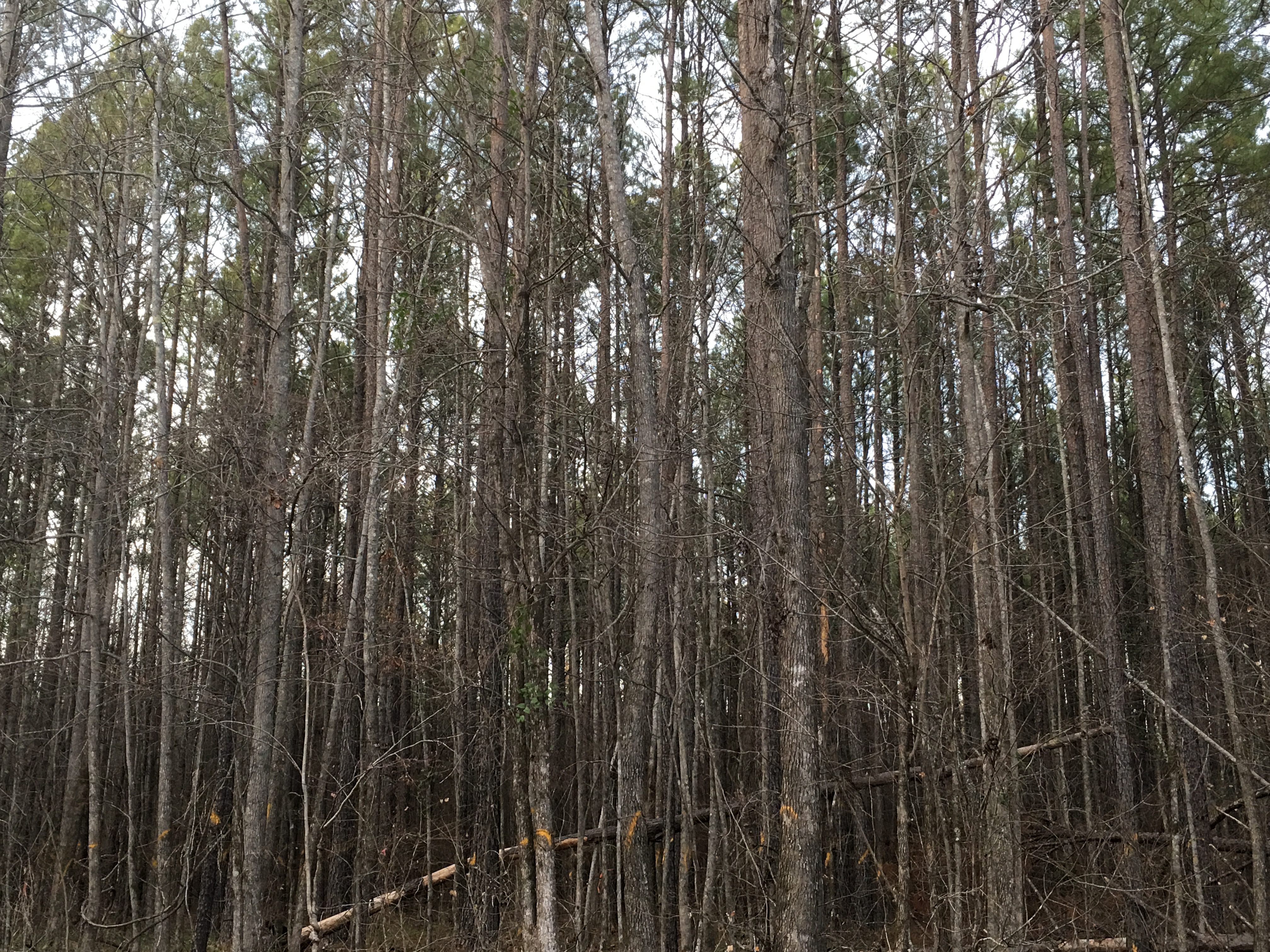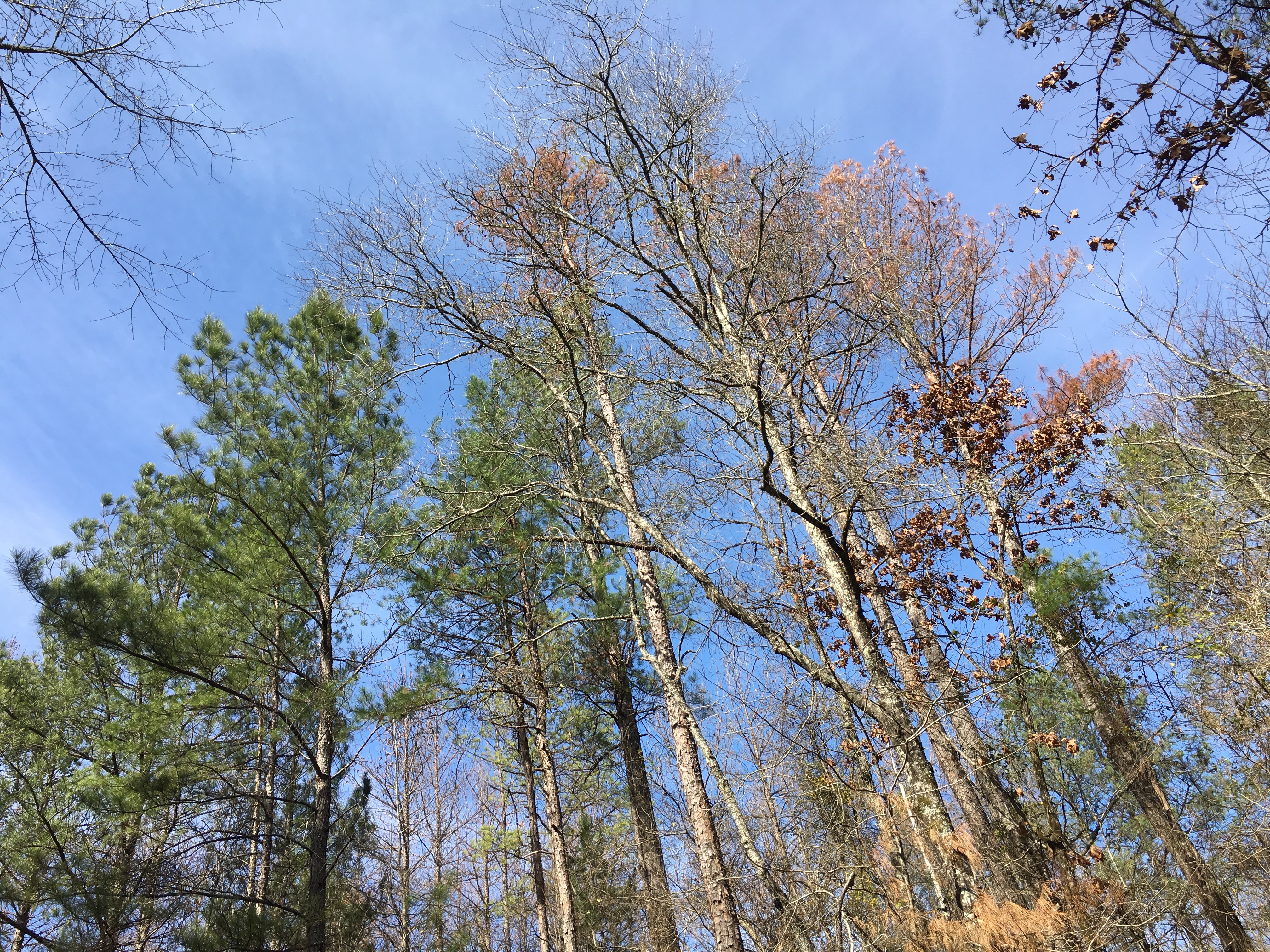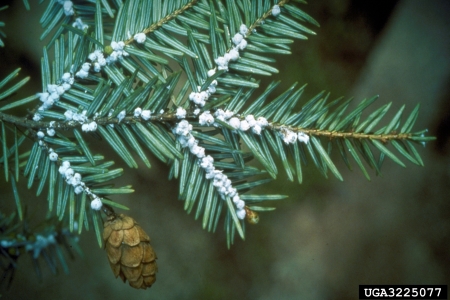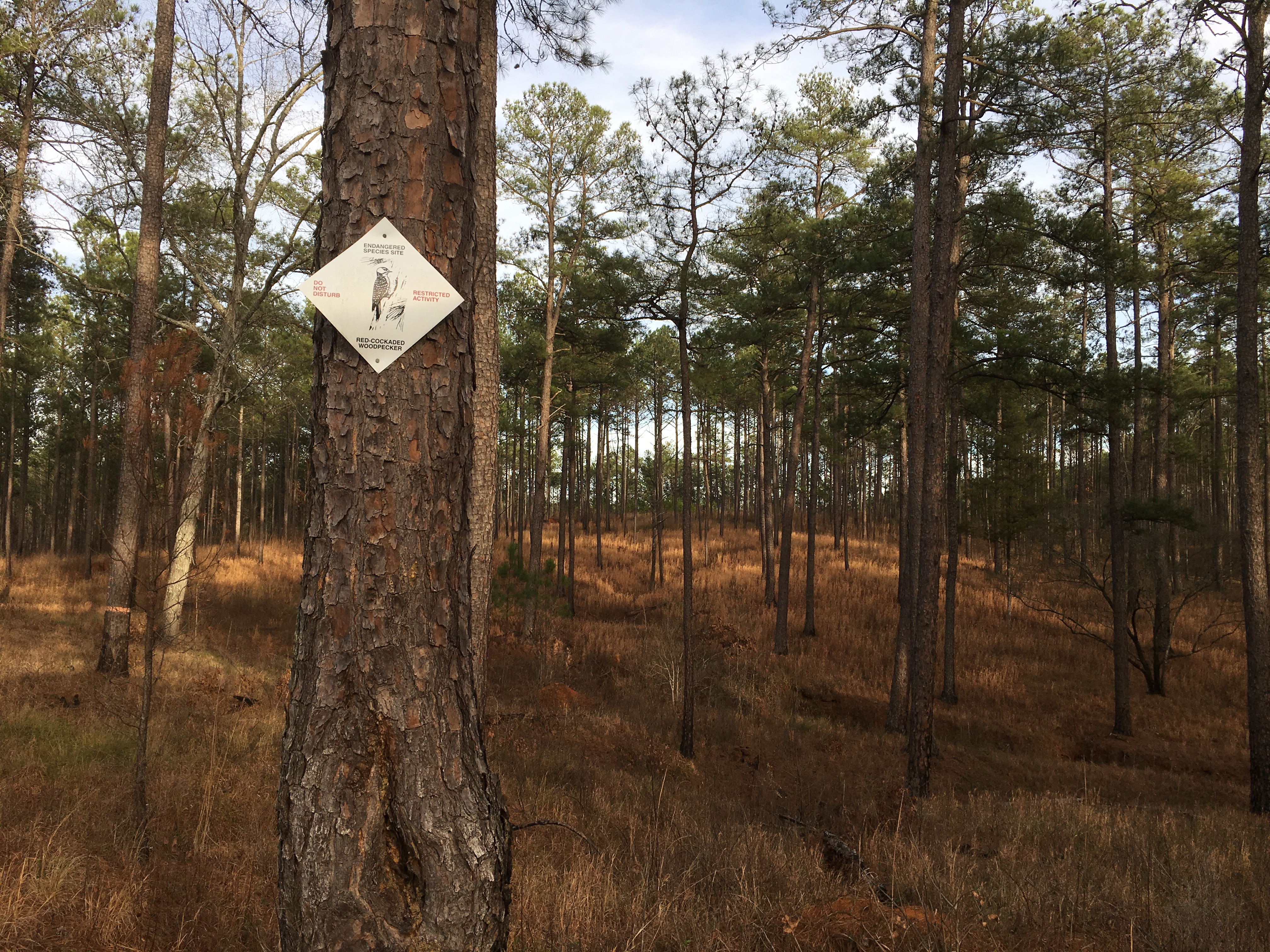Vegetation & Forest Management
Restoring Healthy Forests | Forest Health Protection | Feature Stories | Conserving Southern Yellow Pine | Forest Service Research | Forest Plan Goals and Objectives | Timber Sales
 The overriding objective of the Forest Service's forest management program is to ensure that the National Forests are managed in an ecologically sustainable manner. The National Forests were originally envisioned as working forests with multiple objectives: to improve and protect the forest, to secure favorable watershed conditions, and to furnish a continuous supply of timber for the use of citizens of the United States. Forest management objectives have since expanded and evolved to include ecological restoration and protection, research and product development, fire hazard reduction, and the maintenance of healthy forests. Guided by law, regulation, and agency policy, Forest Service forest managers use timber sales, as well as other vegetation management techniques such as prescibed fire, to achieve these objectives.
The overriding objective of the Forest Service's forest management program is to ensure that the National Forests are managed in an ecologically sustainable manner. The National Forests were originally envisioned as working forests with multiple objectives: to improve and protect the forest, to secure favorable watershed conditions, and to furnish a continuous supply of timber for the use of citizens of the United States. Forest management objectives have since expanded and evolved to include ecological restoration and protection, research and product development, fire hazard reduction, and the maintenance of healthy forests. Guided by law, regulation, and agency policy, Forest Service forest managers use timber sales, as well as other vegetation management techniques such as prescibed fire, to achieve these objectives.
 The Land and Resource Management Plan provides a long-term plan that guides our work as we strive to improve and maintain the health of our national forests in Georgia. There is no objective for any amount of wood volume harvest in this Plan; rather harvest volume is a by-product of management for other purposes. Specific forestwide, management area, or management prescription standards constrain the use of timber harvest. Goals and objectives generally include:
The Land and Resource Management Plan provides a long-term plan that guides our work as we strive to improve and maintain the health of our national forests in Georgia. There is no objective for any amount of wood volume harvest in this Plan; rather harvest volume is a by-product of management for other purposes. Specific forestwide, management area, or management prescription standards constrain the use of timber harvest. Goals and objectives generally include:
- Provide a stable supply of wood products within the historic NF market area as an outcome of achieving non-timber objectives.
- Provide supplies of those wood products where the Forest Service is in a unique position to make an impact on meeting the demand; particularly high-quality raw material for specialty uses.
Vegetation is influenced both by natural processes and humans. Prescribed fire, commercial timber harvest, and noncommercial felling of trees may be used for scenic enhancement or rehabilitation to provide wildlife-viewing or wildlife-hunting opportunities; maintain developed recreation facilities; improve threatened, endangered, sensitive, and locally rare species habitat; restore native vegetative communities; restore riparian ecosystems; reduce unnatural fuel buildups; or control nonnative invasive vegetation.
Mature forests and older stands in various stages of climax canopy development and decline dominate habitat conditions. Management of wildlife/aquatic habitats is for the purpose of enhancing the outstandingly remarkable values of the area. Management activities may include efforts to enhance the fisheries resource, restore native vegetative communities, restore riparian ecosystems, or control nonnative invasive vegetation. Find more details on forest management goals and objectives described in the Forest Plan below.
- Current and recent management activities may be found on the Timber Sales webpage.
- An updated list of projects at various stages in the planning process is also available.
- Find more historical information about forest health projects on the Chattahoochee-Oconee National Forests.
Restoring Healthy Forests
Restoration means creating and maintaining healthy, resilient forests capable of delivering all the benefits that people get from them: clean air and water, carbon sequestration, habitat for native fish and wildlife, forest products, opportunities for outdoor recreation, and more. When we restore our Nation’s forests, we create jobs in rural communities and benefit the environment at the same time.
 |
 |
|
Early successional forests are created by clearing areas for young growth. They provide essential habitats for wildlife. Photo by U.S. Forest Service. |
Early-successional hardwood habitats often support higher densities of ruffed grouse than older stages. |
Guided by law, regulation, and agency policy, forest managers use timber sales, as well as other vegetation management techniques such as prescibed fire, to achieve objectives such as ecological restoration and research. Thinning strategies like femelschlag, through commercial and non-commercial sales, can help to maintain healthy forests and watersheds in an ecologically sustainable manner. There are numerous activities that may affect the biologic integrity of terrestrial wildlife or its habitats, including:
- Restoration and maintenance of declining native pine communities (shortleaf and pitch pine);
- Restoration and maintenance of oak and oak/pine communities;
- Expanding the role of fire as a key to ecological restoration;
- Improving forest structure and function in ways which affect terrestrial wildlife habitat (woodland communities, canopy gap creation, young forest creation, thinning);
- Increasing and improving permanent openings across the project area; and
- Restoration and maintenance of rare habitats (wetlands and bogs, canebrakes).
Managing for Forest Health
Chattahoochee-Oconee National Forest staff work to protect the health of the national forest. Some of the major concerns of forest health include oak decline, dogwood anthracnose, spongy moth, hemlock woolly adelgid, southern pine beetle, nonnative invasive pest plants, and air quality. The management goal is to enhance forest health conditions in forest stands that are: (1) substantially damaged by fire, wind throw, or other catastrophes; or (2) in imminent danger from insect or disease attack. Every year information is collected to monitor trends by measuring activites designed to control or mitigate negative effects of insects, diseases, native and nonnative invasive species, air pollution, and high fuel levels.
|
Tree mortality caused by a pine beetle outbreak on the Oconee National Forest. Photo by U.S. Forest Service. |
Forest Health Protection (FHP) traces its roots to the early 1960's. Plagued by serious insect and disease outbreaks, such as southern pine beetle, chestnut blight, gypsy moth and fusiform rust, the Forest Service saw the need for a specialized unit designed to work exclusively on pest problems related to forest resource productivity and management. The regional unit provides technical assistance in the prevention, detection, evaluation, and suppression of forest insect and disease pest problems. In addition, expertise is available in the areas of seed orchard pest management, nursery disease problems, pesticide use, protection of wood in use, and remote sensing for monitoring insect populations and/or damage.
Current forest health issues include:
Helpful Resources:
- A Field Guide for the Identification of Invasive Plants in Southern Forests
- A Management Guide for Invasive Plants in Southern Forests
- Invasive Species Information, Videos, Distributions, and Maps
- Mapping Invasive Species through EDDMapS
- Forest Service Research on Invasive Species
Feature Stories
Wildlife Habitat Improvement Project Yields Tangible Results
 Investing in wildlife habitat improvement not only benefits the wildlife, it also improves our quality of life and can stimulate the local outdoor sporting industry.
Investing in wildlife habitat improvement not only benefits the wildlife, it also improves our quality of life and can stimulate the local outdoor sporting industry.
Keener Bog: One of Georgia's Rarest Natural Communities
 Mountain Bogs are one of the rarest habitats found in the all of the Southern Appalachians. This is especially true of Georgia's Blue Ridge, where only 15 to 20 true mountain bogs are known.
Mountain Bogs are one of the rarest habitats found in the all of the Southern Appalachians. This is especially true of Georgia's Blue Ridge, where only 15 to 20 true mountain bogs are known.
Hemlocks in Peril
 Hemlocks of Georgia are plagued by hemlock woolly adelgid (HWA) – a tiny non-native insect that quickly kills trees once they become infested. Healthy trees can succumb to adelgid infestations in less than 5 years.
Hemlocks of Georgia are plagued by hemlock woolly adelgid (HWA) – a tiny non-native insect that quickly kills trees once they become infested. Healthy trees can succumb to adelgid infestations in less than 5 years.
The Oconee Forest Health & Wildlife Habitat Improvement Project
![[Photo] A red cockaded woodpecker clings to the side of a tree at the entrance to its nesting cavit](/Internet/FSE_MEDIA/fsm9_028439.jpg) The OFHWHIP is designed to improve the overall health of the Oconee National Forest. Southern pine beetle, drought and storm damage have had serious impacts on the Forest. Management activities developed for the OFHWHIP will maintain or improve forest health, forest diversity, and habitat for wildlife,especially in very dense pine stands. This will improve the ability of the forest to resist damage caused by natural disturbances, disease infestations and insects. And it will allow the forest to recover faster from damage that does occur. Meeting these plan objectives will also help maintain critical habitat for the federally endangered red-cockaded woodpecker.
The OFHWHIP is designed to improve the overall health of the Oconee National Forest. Southern pine beetle, drought and storm damage have had serious impacts on the Forest. Management activities developed for the OFHWHIP will maintain or improve forest health, forest diversity, and habitat for wildlife,especially in very dense pine stands. This will improve the ability of the forest to resist damage caused by natural disturbances, disease infestations and insects. And it will allow the forest to recover faster from damage that does occur. Meeting these plan objectives will also help maintain critical habitat for the federally endangered red-cockaded woodpecker.
Restoring the American Chestnut
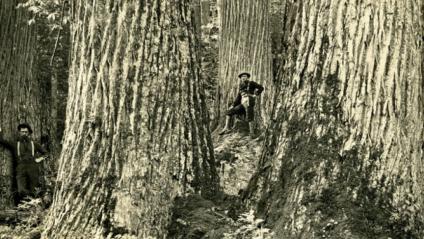 This black and white picture, taken in the mid- to late 19th century, gives an idea of just how large and profuse the American chestnut tree was in Eastern U.S. forests before being nearly completely wiped out by a fungus from Asia. Ranging from Maine to Georgia, the American chestnut tree was counted in the billions. There are now only 100 or so that remain. (Courtesy photo American Chestnut Foundation.) Read more about efforts to restore the American Chestnut. Read more:
This black and white picture, taken in the mid- to late 19th century, gives an idea of just how large and profuse the American chestnut tree was in Eastern U.S. forests before being nearly completely wiped out by a fungus from Asia. Ranging from Maine to Georgia, the American chestnut tree was counted in the billions. There are now only 100 or so that remain. (Courtesy photo American Chestnut Foundation.) Read more about efforts to restore the American Chestnut. Read more:
- Scientists model the effects of restoring the American chestnut tree to the eastern U.S. landscape.
-
What it takes to bring back the near mythical American chestnut trees
-
Reintroducing the American chestnut tree begins with getting the light right
-
Restoring a forest icon: could returning the American chestnut remodel our wildlife landscape?
Conserving Southern Yellow Pine
|
Thinned pine stands, with understory competition treated with prescribed fire, restore habitat for wildlife. Photos by U.S. Forest Service. |
Chapter 2 of the Land and Resource Management Plan describes Forestwide goals for terrestrial plants and animals and their associated habitats. Specifically, this includes activities to enhance, restore, manage and create habitats as required for wildlife and plant communities, including disturbance-dependent forest types.
Several forest types are generally described as Southern Yellow Pine and may include: shortleaf pine forests, pitch pine forests, open woodlands, savannas, and grasslands, mountain longleaf pine and longleaf pine-oak forests, oak or oak-pine forests, and high elevation early-successional habitats. Below are details about a few of these special forest types found on the Chattachoochee and Oconee National Forests.
Table Mountain Pine
 Table Mountain pine is endemic to the Appalachian Mountains of the eastern United States. Its distribution is primarily in the Blue Ridge and Valley-and-Ridge provinces of the Appalachian Highlands although its range extends from central Pennsylvania, southwest to eastern West Virginia and southward into North Carolina, Tennessee, and the extreme northeast corner of Georgia.
Table Mountain pine is endemic to the Appalachian Mountains of the eastern United States. Its distribution is primarily in the Blue Ridge and Valley-and-Ridge provinces of the Appalachian Highlands although its range extends from central Pennsylvania, southwest to eastern West Virginia and southward into North Carolina, Tennessee, and the extreme northeast corner of Georgia.
Table Mountain pine (Pinus pungens Lambert) was historically a widespread pine species native to the central and southern Appalachian Mountains, but, in recent decades, its current natural distribution has been reduced to less than 30,000 ac (12,000 ha). Reasons for this decline include wildfire suppression programs of the early 20th century, southern pine beetle outbreaks, and recent climate fluctuations.
The age class structure of many Table Mountain pine stands suggests that fire is an important influence on stand structure and regeneration. Many Table Mountain pine stands observed on the Chattahoochee National Forest, Georgia are represented by large DBH size classes, suggesting older age classes, and show no evidence of pine regeneration. Cones of Table Mountain pine are typically serotinous, requiring high temperatures from solar radiation or fire to loosen the resin and release the seeds. Stands dominated by Table Mountain pine are usually associated with exposed rocky sites with shallow soil over bedrock or a very high rock content.
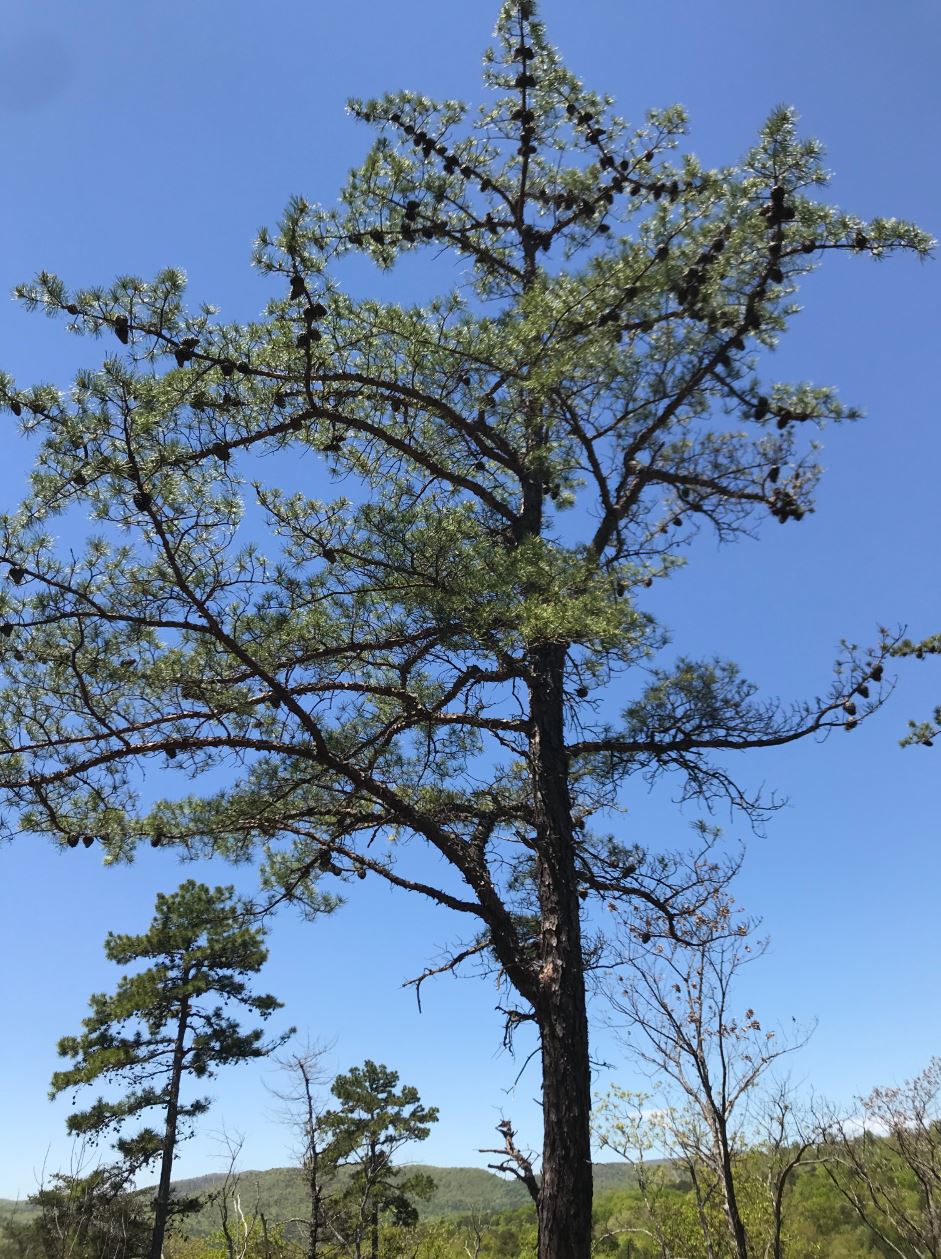 |
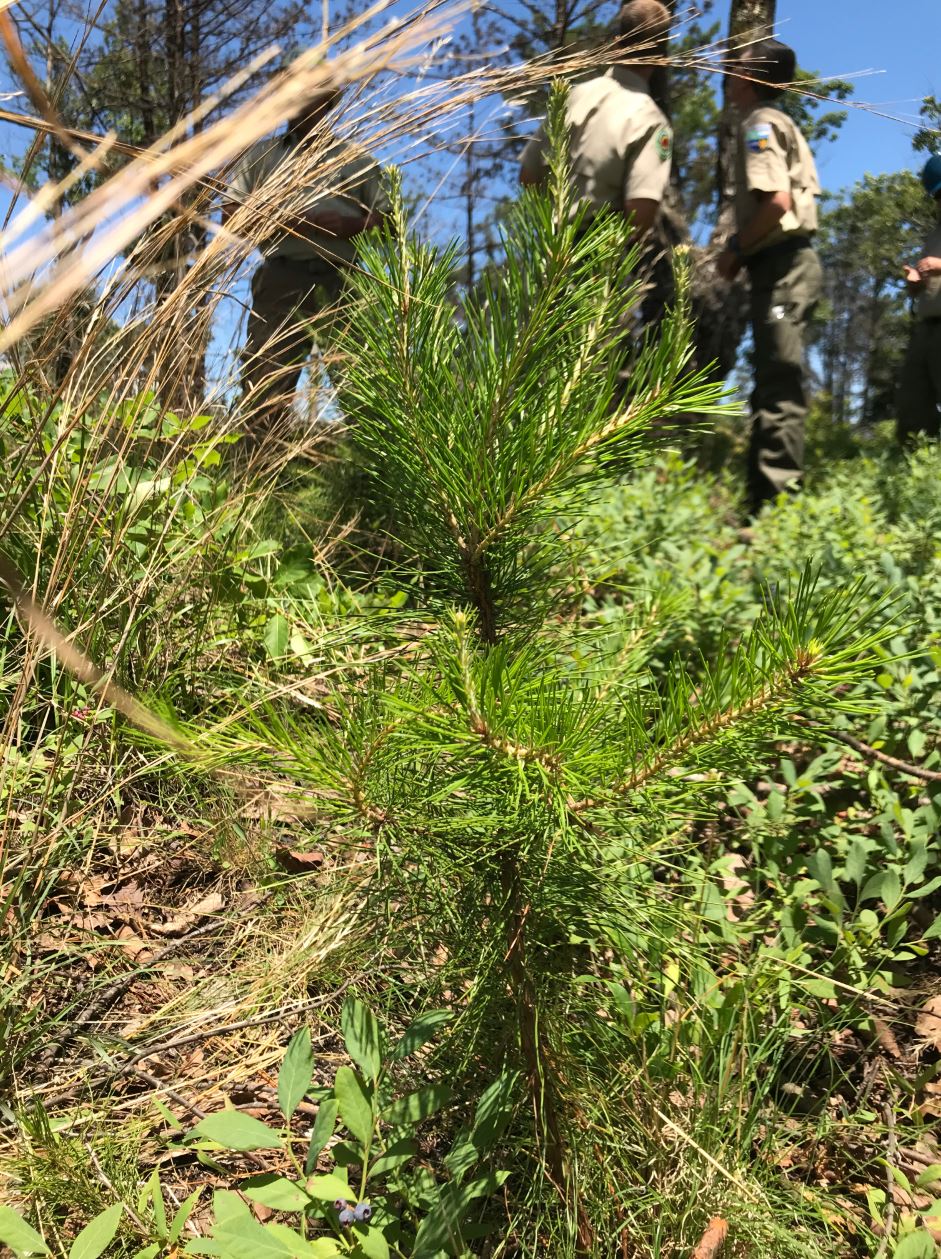 |
|
Table Mountain Pine - Pinus pugens - a tree species in need of restoration treatments. |
A seedling of Table Mountain Pine - Pinus pugens - reestablished after a prescribed fire. |
Shortleaf Pine
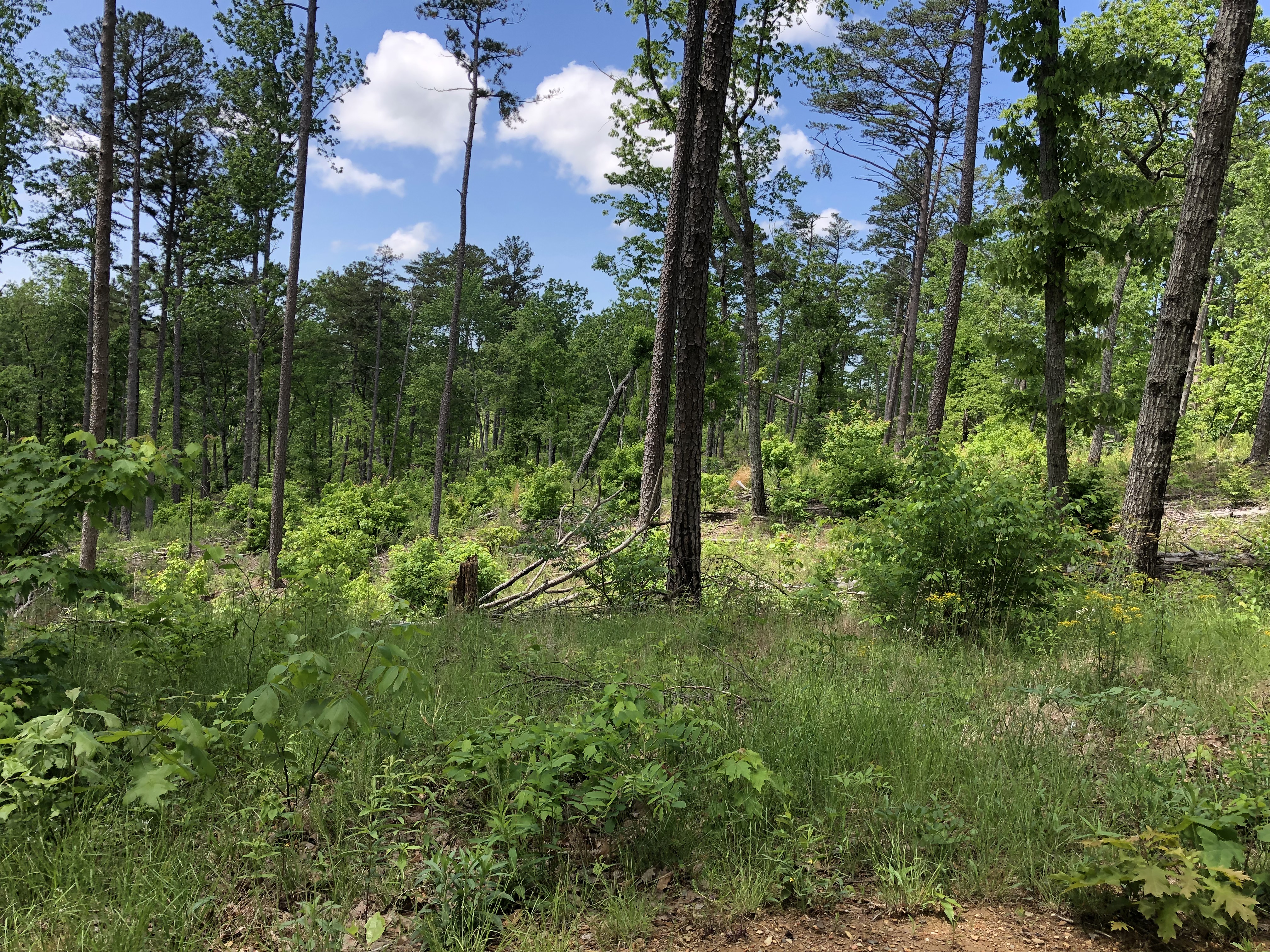 |
|
Shortleaf restoration on the Chattahoochee National Forest on the Sumac Creek Watershed Project. The conditions in the Sumac Creek Project Area indicate a need to restore and maintain shortleaf pine and xeric oak woodland communities; maintain oak communities; improve forest health; and increase structural diversity. Photo by U.S. Forest Service. |
A fire-maintained, shortleaf pine woodland (Shortleaf Pine / Little Bluestem Appalachian Woodland) occurred historically in the Appalachian regions of Alabama, north through Georgia, Tennessee, and Kentucky on dry ridges and slopes or rock outcrops. On broad ridges in the Ridge and Valley and the southern end of the Blue Ridge in northeastern Alabama and northwestern Georgia, shortleaf occurs with both post oak and chestnut oak. With fire, it is an open woodland (Shortleaf Pine - Post Oak - Chestnut Oak / Poverty Oatgrass Forest), but with a reduced fire frequency other more mesic oaks and sourwood (Oxydendrum arboreum) are found in the understory.
Shortleaf pine forests and associated habitats once covered a vast area of the continent stretching from eastern Texas and Oklahoma to the eastern seaboard from New Jersey down to Florida. Early settlers and Government Land Office surveys describe these pine dominated and mixed pine-oak forests as open woodlands where sunlight reached the ground and a diverse assortment of native wildlife flourished.
 Over the last 30 years, this extensive shortleaf pine ecosystem has lost over 50 percent of its former acreage with most of the significant decline taking place east of the Mississippi River. Massive pine beetle outbreaks in poorly managed stands, changes in timber management practices, altered fire regimes, disease, and land use changes have contributed to this rapid decline. These forested landscapes across twenty two states represent an extraordinary diversity of cultural, ecological and economic values centered on wildlife and recreation, water quality, and a high-value wood products industry. With millions of people depending on the values and benefits of this imperiled ecosystem, the need to develop a range-wide conservation strategy is more compelling than ever.
Over the last 30 years, this extensive shortleaf pine ecosystem has lost over 50 percent of its former acreage with most of the significant decline taking place east of the Mississippi River. Massive pine beetle outbreaks in poorly managed stands, changes in timber management practices, altered fire regimes, disease, and land use changes have contributed to this rapid decline. These forested landscapes across twenty two states represent an extraordinary diversity of cultural, ecological and economic values centered on wildlife and recreation, water quality, and a high-value wood products industry. With millions of people depending on the values and benefits of this imperiled ecosystem, the need to develop a range-wide conservation strategy is more compelling than ever.
Longleaf Pine
|
A U.S. Forest Service employee inspects a Longleaf pine planting on the Chattahoochee-Oconee National Forests after a prescribed fire. Photo by U.S. Forest Service. |
The fire-dependent longleaf pine ecosystem was historically the dominant forest type across the Southeast, but fire suppression and conversion to other land uses or forest types reduced longleaf acreage to less than 5 percent of its original extent. The extensive loss of longleaf pine was a dramatic change in the region, as these forests contain some of the most important natural areas for plants and wildlife in the United States. Longleaf pine forests represent an extraordinary wealth of cultural, ecological, economic and social values – all on the same acres.
Wildlife value: Longleaf natural areas provide habitat for a suite of rare, atrisk, and endangered species as well as enhanced habitat for game species, thus improving recreational opportunities.
Benefits for people: Longleaf forests provide clean air and water sources, provide buffers from wildfire, and mitigate damage from hurricanes.
Risk abatement: Longleaf trees are more wind-firm, drought and fire tolerant, and less susceptible to losses from pine beetle or disease outbreaks.
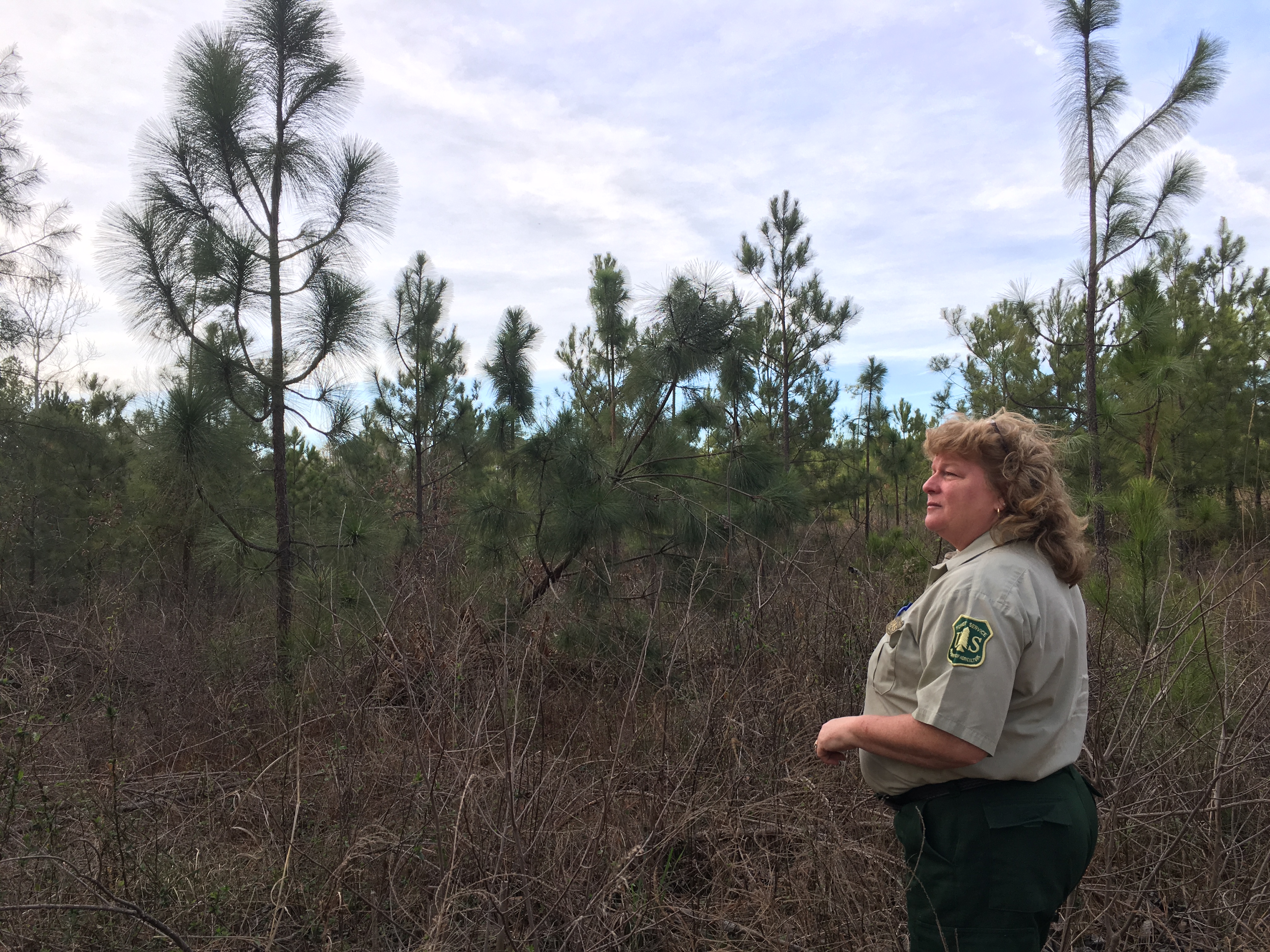 The America's Longleaf Restoration Initiative (ALRI) is a collaborative effort of multiple public and private sector partners that actively supports range-wide efforts to restore and conserve longleaf pine ecosystems. The vision of the partners involved in the ALRI is to have functional, viable longleaf pine ecosystems with the full spectrum of ecological, economic and social values inspired through the voluntary involvement of motivated organizations and individuals.
The America's Longleaf Restoration Initiative (ALRI) is a collaborative effort of multiple public and private sector partners that actively supports range-wide efforts to restore and conserve longleaf pine ecosystems. The vision of the partners involved in the ALRI is to have functional, viable longleaf pine ecosystems with the full spectrum of ecological, economic and social values inspired through the voluntary involvement of motivated organizations and individuals.
Forest Service Research
|
Aerial view of experimental gap treatment for Hemlock. Photo by U.S. Forest Service. |
Find the latest Forest Service research about forest restoration and management. Below are a few research articles highlighting the latest research about managing a healthy forest:
-
How Drought and Thinning Affect Water Balances in Southeastern Pine Plantations
-
What it takes to bring back the near mythical American chestnut trees
-
Eastern hemlock released from shade in field experiment. Photo by Bud Mayfield, USFS.
-
Thinning and Burning: The Best Defense Against Southern Pine Beetle
-
Restoring a forest icon: could returning the American chestnut remodel our wildlife landscape?
Other Information Resources
- Fire Effects Information System (FEIS) - Syntheses about fire ecology and fire regimes in the United States
- PLANTS Database by NRCS
- NatureServe Explorer - plants, animals, and ecosystems, including rare and endangered species.
All Research Categories
- Biomass and Bioenergy 39 posts
- Bottomland Hardwoods 41 posts
- Climate Change 171 posts
- Disturbance 35 posts
- Economics & Policy 107 posts
Table Mountain pine grows on dry, rocky ridges in the southern Appalachian Mountains. Photo by Barbara Crane.
- Ethics & Values 71 posts
- Experimental Forests 97 posts
- Fire 99 posts
- Fish & Wildlife 118 posts
- Forest Health Protection 49 posts
- Forest Inventory & Analysis 85 posts
- Forest Landowners 108 posts
- Forest Operations 57 posts
- Forest Products 76 posts
- Forest Watersheds 165 posts
- Genetics 41 posts
- Insects and Diseases 156 posts
- Integrating Human & Natural Systems 21 posts
- Invasive Plants 52 posts
- Longleaf Pines 66 posts
- National Forests 80 posts
- Non-Timber Forest Products 27 posts
- Pollinator Garden 9 posts
- Recreation 26 posts
- Restoration 151 posts
- Southern Pines 92 posts
- Threats 256 posts
- Tools 25 posts
- Uncategorized 23 posts
- Upland Hardwoods 84 posts
- Urban Forests 42 posts
- Women in Science 11 posts
Forest Plan Goals and Objectives
The Land and Resource Management Plan provides a long-term plan that guides our work as we strive to improve and maintain the health of our national forests in Georgia. Chapter 2 describes Forestwide goals for terrestrial plants and animals and their associated habitats. Specifically, goal 3 describes objectives to enhance, restore, manage and create habitats as required for wildlife and plant communities, including disturbance-dependent forest types.
OBJECTIVE 3.1 Within the first 10 years of Plan implementation restore 1,100 acres of shortleaf pine forests on the Chattahoochee on sites where they once likely occurred.
OBJECTIVE 3.2 Within the first 10 years of Plan implementation restore 1,000 acres of pitch pine forests on the Chattahoochee on sites where they once likely occurred.
OBJECTIVE 3.3 Within the first 10 years of Plan implementation restore 1,100 acres of shortleaf pine forests on the Oconee on sites where it once likely occurred.
OBJECTIVE 3.4 Within the first 10 years of Plan implementation restore 10,000 acres of open woodlands, savannas, and grasslands on the Chattahoochee and 1,000 acres on the Oconee. Once created, maintain woodlands, savannas, and grasslands on a five-year burning cycle or less.
OBJECTIVE 3.5 Within the first 10 years of Plan implementation restore 1,100 acres of mountain longleaf pine and longleaf pine-oak forests within the Southern Ridge and Valley ecological section on sites where they once likely occurred.
OBJECTIVE 3.6 Within the first 10 years of Plan implementation restore oak or oak-pine forests on 1,250 acres on the Chattahoochee and 550 acres on the Oconee on appropriate sites currently occupied by pine plantations or other hardwood species such as gum and maple.
OBJECTIVE 3.7 To maintain existing oak and oak-pine forests, reduce stem density on 5,500 acres on the Chattahoochee, and 5,200 acres on the Oconee of these forest types within the first 10 years of Plan implementation.
OBJECTIVE 3.8 Create and maintain an annual average of 300 acres above 3,000 feet elevation in early-successional habitats, achieving 3,000 acres within the first 10 years of Plan implementation. This acreage may be comprised of regenerating forests (0-10 years), utility rights-of-way, and open woodlands.
Current and recent management activities may be found on the Timber Sales webpage.
An updated list of projects at various stages in the planning process is also available.
Find more historical information about forest health projects on the Chattahoochee-Oconee National Forests.
Historic GIS Data:
- Management Activities on the Chattahoochee-Oconee National Forests 2009-2018 (available as a kmz file for use in Google Earth and also as an ArcMap geodatabase)
- Wildfires on the Chattahoochee-Oconee National Forests 2007-2018 (availalbe as a kmz file for use in Google Earth and also as an ArcMap geodatabase)



